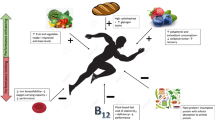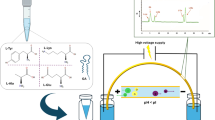Abstract
As recently reported, dried blood spot (DBS) analysis is an advantageous technique for doping control purposes due to the minimal invasive sample collection, the simple and economic manner, as well as the low susceptibility to manipulation. Its general applicability to the sports drug testing arena has been shown for analytes of various substance classes, all of which comprise exclusively low molecular mass compounds. The aim of the present study was to investigate whether the technique of DBS analysis is applicable also to (pegylated) peptides with relevance for doping controls. As target analyte, peginesatide (Omontys, Hematide), a recently approved pegylated erythropoietin-mimetic peptide of approximately 45 kDa, tested for the treatment of anaemia in patients with renal failure, was chosen, which has been prohibited in elite sports due to its assumed endurance enhancing effects. Therefore, a detection method for peginesatide employing DBS was developed based on extraction, proteolytic digestion and cation-exchange purification followed by liquid chromatography–tandem mass spectrometry analysis. Eventually, the assay was validated for qualitative purposes and proved to be specific, sensitive (limit of detection, 10 ng/mL) and precise (relative standard deviations below 18 %), demonstrating the general suitability of DBS analysis in sports drug testing also for (pegylated) peptides.




Similar content being viewed by others
References
Guthrie R, Susi A (1963) A simple phenylalanine method for detecting phenylketonuria in large populations of newborn infants. Pediatrics 32:338–343
Millership JS (2011) Microassay of drugs and modern measurement techniques. Bioanalysis 3:197–205
Edelbroek PM, van der Heijden J, Stolk LM (2009) Dried blood spot methods in therapeutic drug monitoring: methods, assays, and pitfalls. Ther Drug Monit 31:327–336
Burnett JE (2011) Dried blood spot sampling: practical considerations and recommendation for use with preclinical studies. Bioanalysis 3:1025–1030
Pandya HC, Spooner N, Mulla H (2011) Dried blood spots, pharmacokinetic studies and better medicines for children. Bioanalysis 3:779–786
Patel P, Mulla H, Tanna S, Pandya H (2010) Facilitating pharmacokinetic studies in children: a new use of dried blood spots. Arch Dis Child 95:484–487
Parker SP, Cubitt WD (1999) The use of the dried blood spot sample in epidemiological studies. J Clin Pathol 52:633–639
McDade TW, Williams S, Snodgrass JJ (2007) What a drop can do: dried blood spots as a minimally invasive method for integrating biomarkers into population-based research. Demography 44:899–925
Li W, Tse FL (2010) Dried blood spot sampling in combination with LC-MS/MS for quantitative analysis of small molecules. Biomed Chromatogr 24:49–65
Wilhelm AJ, den Burger JC, Vos RM, Chahbouni A, Sinjewel A (2009) Analysis of cyclosporin A in dried blood spots using liquid chromatography tandem mass spectrometry. J Chromatogr B Analyt Technol Biomed Life Sci 877:1595–1598
Li W, Williams SM, Smith HT, Tse FL (2011) Quantitative analysis of NIM811, a cyclophilin inhibitor, in human dried blood spots using liquid chromatography-tandem mass spectrometry. J Chromatogr B Analyt Technol Biomed Life Sci 879:2376–2382
Ewles MF, Turpin PE, Goodwin L, Bakes DM (2011) Validation of a bioanalytical method for the quantification of a therapeutic peptide, ramoplanin, in human dried blood spots using LC-MS/MS. Biomed Chromatogr 25:995–1002
Kehler JR, Bowen CL, Boram SL, Evans CA (2010) Application of DBS for quantitative assessment of the peptide Exendin-4; comparison of plasma and DBS method by UHPLC-MS/MS. Bioanalysis 2:1461–1468
deWilde A, Sadilkova K, Sadilek M, Vasta V, Hahn SH (2008) Tryptic peptide analysis of ceruloplasmin in dried blood spots using liquid chromatography-tandem mass spectrometry: application to newborn screening. Clin Chem 54:1961–1968
Kehler JR, Akella N, Citerone D, Szapacs M (2011) Application of DBS for the quantitative assessment of a protein biologic using on-card digestion LC-MS/MS or immunoassay. Bioanalysis 3:2283–2290
Sleczka BG, D’Arienzo CJ, Tymiak AA, Olah TV (2012) Quantitation of therapeutic proteins following direct trypsin digestion of dried blood spot samples and detection by LC-MS-based bioanalytical methods in drug discovery. Bioanalysis 4:29–40
Wong P, Pham R, Bruenner BA, James CA (2010) Increasing efficiency for dried blood spot analysis: prospects for automation and simplified sample analysis. Bioanalysis 2:1787–1789
Thomas A, Geyer H, Guddat S, Schänzer W, Thevis M (2011) Dried blood spots (DBS) for doping control analysis. Drug Test Analysis 3:806–813
El Ezzi AA, El-Saidi MA, Kuddus RH (2010) Long-term stability of thyroid hormones and DNA in blood spots kept under varying storage conditions. Pediatr Int 52:631–639
Thomas A, Geyer H, Schänzer W, Crone C, Kellmann M, Moehring T, Thevis M (2012) Sensitive determination of prohibited drugs in dried blood spots (DBS) for doping controls by means of a benchtop quadrupole/Orbitrap mass spectrometer. Anal Bioanal Chem. doi:10.1007/s00216-011-5655-2
Peng SH, Segura J, Farre M, de la Torre X (2000) Oral testosterone administration detected by testosterone glucuronidation measured in blood spots dried on filter paper. Clin Chem 46:515–522
WADA (2011) The 2012 prohibited list—international standard. WADA (World Anti-Doping Agency). Available from: http://www.wada-ama.org/Documents/World_Anti-Doping_Program/WADP-Prohibited-list/2012/WADA_Prohibited_List_2012_EN.pdf. Accessed December 2011
Macdougall IC (2008) Hematide, a novel peptide-based erythropoiesis-stimulating agent for the treatment of anemia. Curr Opin Investig Drugs 9:1034–1047
Woodburn KW, Holmes CP, Wilson SD, Fong KL, Press RJ, Moriya Y, Tagawa Y (2012) Absorption, distribution, metabolism and excretion of peginesatide, a novel erythropoiesis-stimulating agent, in rats. Xenobiotica. doi:10.3109/00498254.2011.649310
Macdougall IC, Rossert J, Casadevall N, Stead RB, Duliege AM, Froissart M, Eckardt KU (2009) A peptide-based erythropoietin-receptor agonist for pure red-cell aplasia. N Engl J Med 361:1848–1855
Macdougall IC (2012) New anemia therapies: translating novel strategies from bench to bedside. Am J Kidney Dis 59:444–451
Affymax (2011) Affymax and Takeda Announce the Submission of a New Drug Application for Peginesatide for the Treatment of Anemia Associated with Chronic Renal Failure in Patients on Dialysis. Affymax Inc. Available from: http://www.investors.affymax.com/releasedetail.cfm?ReleaseID=581773. Accessed January 2012
FDA (2012) FDA approves Omontys to treat anemia in adult patients on dialysis. U.S. Food and Drug Administration. Available from: http://www.fda.gov/NewsEvents/Newsroom/PressAnnouncements/ucm297464.htm. Accessed March 2012
Möller I, Thomas A, Geyer H, Schänzer W, Thevis M (2011) Synthesis, characterisation, and mass spectrometric detection of a pegylated EPO-mimetic peptide for sports drug testing purposes. Rapid Commun Mass Spectrom 25:2115–2123
Leuenberger M, Saugy J, Mortensen RB, Schatz P, Giraud S, Saugy M (2011) Methods for detection and confirmation of Hematide™/peginesatide in anti-doping samples. Forensic Sci Int 213:15–19
Woo S, Krzyzanski W, Duliege AM, Stead RB, Jusko WJ (2008) Population pharmacokinetics and pharmacodynamics of peptidic erythropoiesis receptor agonist (ERA) in healthy volunteers. J Clin Pharmacol 48:43–52
ICH (2005) Validation of analytical procedures: text and methodology Q2(R1). ICH (International Conference on Harmonisation). Available from: http://www.ich.org/fileadmin/Public_Web_Site/ICH_Products/Guidelines/Quality/Q2_R1/Step4/Q2_R1__Guideline.pdf. Accessed January 2012
Youhnovski N, Bergeron A, Furtado M, Garofolo F (2011) Pre-cut dried blood spot (PCDBS): an alternative to dried blood spot (DBS) technique to overcome hematocrit impact. Rapid Commun Mass Spectrom 25:2951–2958
Patel P, Tanna S, Mulla H, Kairamkonda V, Pandya H, Lawson G (2010) Dexamethasone quantification in dried blood spot samples using LC-MS: the potential for application to neonatal pharmacokinetic studies. J Chromatogr B Analyt Technol Biomed Life Sci 878:3277–3282
Bonfiglio R, King RC, Olah TV, Merkle K (1999) The effects of sample preparation methods on the variability of the electrospray ionization response for model drug compounds. Rapid Commun Mass Spectrom 13:1175–1185
Affymax (2011) Efficacy and safety of Hematide™ injection in the treatment of anemia in patients with chronic kidney disease. U.S. National Library of Medicine. Available from: http://www.clinicaltrials.gov/ct2/show/NCT00314795?term=hematide&rank=4. Accessed January 2012
GE Healthcare (2010) FTA™ DMPK Card Selection. General Electric Company. Available from: http://www.whatman.com/References/FTA%20DMPK%20Card%20Selection%20Guide.pdf. Accessed January 2012
Vergouwen PC, Collee T, Marx JJ (1999) Haematocrit in elite athletes. Int J Sports Med 20:538–541
Acknowledgements
The study was carried out with support of the Fonds of the Chemical Industry (Frankfurt am Main, Germany), Antidoping Switzerland (Berne, Switzerland), and the Federal Ministry of the Interior of the Federal Republic of Germany (Berlin, Germany).
Author information
Authors and Affiliations
Corresponding author
Rights and permissions
About this article
Cite this article
Möller, I., Thomas, A., Geyer, H. et al. Development and validation of a mass spectrometric detection method of peginesatide in dried blood spots for sports drug testing. Anal Bioanal Chem 403, 2715–2724 (2012). https://doi.org/10.1007/s00216-012-6043-2
Received:
Revised:
Accepted:
Published:
Issue Date:
DOI: https://doi.org/10.1007/s00216-012-6043-2




